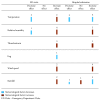Effects of Meteorological Factors on Hospitalizations in Adult Patients with Asthma: A Systematic Review
- PMID: 31281551
- PMCID: PMC6589223
- DOI: 10.1155/2019/3435103
Effects of Meteorological Factors on Hospitalizations in Adult Patients with Asthma: A Systematic Review
Abstract
Background: Environmental factors such as weather variables contribute to asthma exacerbation. The impact of meteorological factors on asthma-related hospital admissions (HAs) or emergency department visits (EDVs) has been assessed in the literature. We conducted a systematic review to establish a conclusion of whether these findings from the literature are consistent and generalizable or if they vary significantly by certain subgroups.
Objective: This study aims to review the effect of meteorological variables on asthma HAs and EDVs in adults, to identify knowledge gaps and to highlight future research priorities.
Method: A systematic search was conducted in electronic databases such as PubMed, Embase, and CINAHL. All studies published in English were screened and included if they met the eligibility criteria. Two independent reviewers assessed the quality of the studies and extracted the data. The available evidence was summarized and presented using a harvest plot.
Results: Our initial search returned a total of 3887 articles. After screening titles, abstracts, and full texts, 16 studies were included. Thirty-one percent of the included studies (5/16) found that temperature was the only factor associated with asthma hospitalization or EDVs. Six studies (37%) found that both temperature and relative humidity were associated with HAs. Four studies (25%) identified thunderstorms as a possible factor associated with asthma hospitalization in adults.
Conclusion: Our review suggests that HAs and EDVs due to asthma are associated with many meteorological factors. Among the articles included in this review, changing temperature is the most commonly studied variable. We did not find studies that measured barometric pressure, weather phenomena, or the effect of tornados. To develop effective strategies to protect subjects at risk, further studies are required.
Figures


References
-
- Marino P., Bryden C., Bird W., Watkin H. A. How different measures of cold weather affect chronic obstructive pulmonary disease (COPD) hospital admissions in London. European Respiratory Review. 2006;15(101):185–186. doi: 10.1183/09059180.00010126. - DOI
-
- Li M., Li Q., Yang G., Kolosov V. P., Perelman J. M., Zhou X. D. Cold temperature induces mucin hypersecretion from normal human bronchial epithelial cells in vitro through a transient receptor potential melastatin 8 (TRPM8)-mediated mechanism. Journal of Allergy and Clinical Immunology. 2011;128(3):626–634.e5. doi: 10.1016/j.jaci.2011.04.032. - DOI - PubMed
Publication types
MeSH terms
LinkOut - more resources
Full Text Sources
Medical
Miscellaneous

